Hair Loss In Male: Causes & Prevention
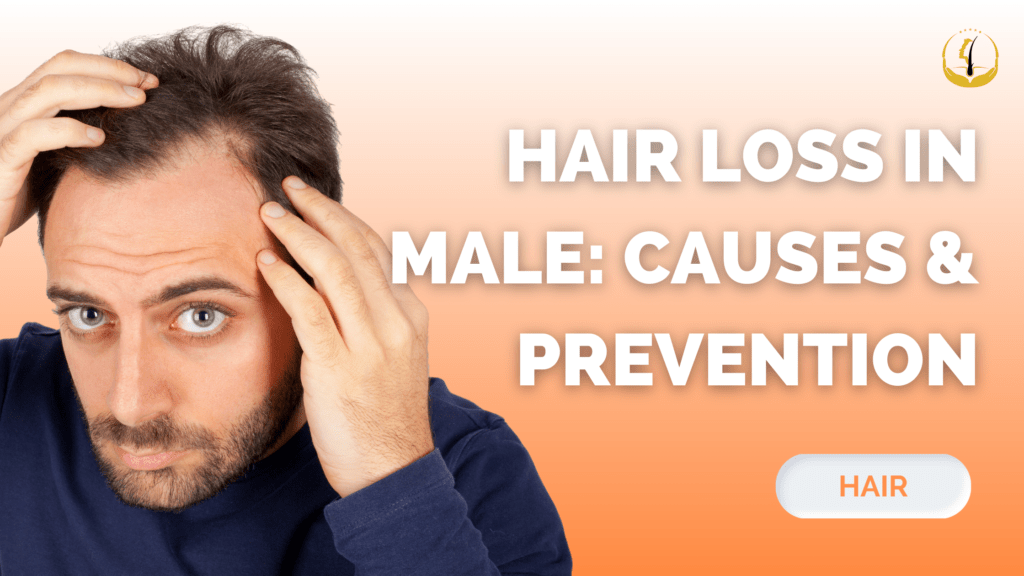
Hair loss, a common concern among men, can be a distressing experience that affects self-esteem and confidence. It’s essential to understand the various causes of hair loss and explore effective prevention strategies to maintain a healthy head of hair. Let’s explore the causes of hair loss in males and provide valuable tips for preventing and managing this condition. Common Causes of Hair Loss in Males Androgenetic Alopecia (Male Pattern Baldness) Androgenetic alopecia, often referred to as male pattern baldness, is the most common cause of hair loss in men. It’s characterized by a receding hairline and thinning hair on the crown, leading to eventual baldness. This condition is primarily genetic and influenced by hormones, particularly dihydrotestosterone (DHT), which shrinks hair follicles over time. Telogen Effluvium Telogen effluvium is a temporary form of hair loss triggered by significant stressors, such as illness, surgery, or emotional distress. It disrupts the normal hair growth cycle, causing a sudden increase in hair shedding. However, it’s usually reversible once the underlying stressor is resolved. Alopecia Areata Alopecia areata is an autoimmune disorder where the body’s immune system mistakenly attacks hair follicles, leading to patchy hair loss on the scalp. While the exact cause is unknown, genetics and environmental factors may play a role. Medications and Treatments Some medications, like chemotherapy drugs and certain blood pressure medications, can cause hair loss as a side effect. Radiation therapy can also lead to localized hair loss in treated areas. Nutritional Deficiencies Inadequate intake of essential nutrients, especially iron, biotin, and protein, can contribute to hair loss. Nutritional deficiencies weaken hair follicles and disrupt the hair growth cycle. Prevention and Management of Hair Loss Now that we’ve covered the common causes of hair loss in males, let’s explore effective prevention and management strategies: Maintain a Healthy Lifestyle A balanced diet rich in vitamins, minerals, and proteins is crucial for healthy hair growth. Incorporate foods like eggs, nuts, spinach, and lean meats into your diet. Regular exercise and stress management techniques can also help maintain overall well-being, reducing the risk of telogen effluvium. Avoid Harsh Hairstyles and Hair Products Tight hairstyles like cornrows and excessive use of styling products or heat treatments can damage hair and lead to hair loss. Opt for gentler styles and minimize the use of harsh chemicals and heat. Medications and Supplements For androgenetic alopecia, there are FDA-approved medications like minoxidil and finasteride that can slow hair loss and promote regrowth. Consult a healthcare professional before starting any medication. Platelet-Rich Plasma (PRP) Therapy PRP therapy involves injecting a patient’s own platelet-rich plasma into the scalp, which can stimulate hair follicles and promote hair growth. It’s a minimally invasive option for some types of hair loss. Hair Transplant Surgery In cases of advanced male pattern baldness, hair transplant surgery can be a viable option. It involves transplanting hair follicles from donor areas (usually the back of the head) to balding areas. This procedure can provide long-lasting results, but it’s essential to consult with a qualified surgeon. Use Gentle Hair Care Products Choose mild, sulfate-free shampoos and conditioners that promote scalp health. Regularly washing and keeping the scalp clean can prevent clogged follicles and infection. Stay Informed and Seek Professional Help If you notice excessive or sudden hair loss, it’s crucial to consult a dermatologist or hair specialist for a proper diagnosis and personalized treatment plan. Hair loss in males can be caused by a variety of factors, but understanding the root cause is the first step in addressing the issue effectively. By adopting a healthy lifestyle, avoiding damaging hair practices, and exploring suitable treatments, you can minimize the impact of hair loss and maintain a confident and healthy appearance. Remember that seeking professional guidance is essential to determine the most suitable prevention and treatment options for your specific condition. Click the link to learn more about Hair Loss: “Understanding Male Pattern Hair Loss through the Norwood Scale’s Class 1–7” At Glojas, we welcome clients to reach out to us directly to schedule a free initial consultation. We offer guidance and valuable insights on how best to address your specific challenges. Let us assist you in navigating your journey with confidence and clarity.
Hair Loss: What is Cytokines?

Hair loss is a common concern for many individuals, affecting both men and women of all ages. It can lead to a loss of self-confidence and impact one’s self-esteem. In recent years, there has been a growing interest in understanding the underlying causes of hair loss and exploring various treatment options, including hair transplant surgery and hair restoration techniques such as FUE and FUT hair transplants. One intriguing aspect of hair loss research revolves around the role of cytokines in this process. Let’s explore deeper into what cytokines are and how they relate to hair loss. What Are Cytokines in Hair Loss? Cytokines are small proteins produced by various cells in the body, including immune cells, to regulate inflammation, immune responses, and communication between cells. They play a crucial role in maintaining the body’s overall health and are involved in various physiological processes. However, when cytokines become imbalanced or overactive, they can contribute to a range of health issues, including hair loss. The Link Between Cytokines and Hair Loss Researchers have discovered that an imbalance of certain cytokines in the scalp can lead to hair loss. One of the key cytokines involved in this process is called Tumor Necrosis Factor-alpha (TNF-alpha). When TNF-alpha is present in excessive amounts in the scalp, it can trigger inflammation, disrupt hair follicle functioning, and ultimately lead to hair loss. Inflammation and Hair Loss Chronic inflammation is one of the primary mechanisms through which cytokines can contribute to hair loss. Inflammation can damage hair follicles, making it difficult for them to produce healthy, strong hair strands. This inflammation can also disrupt the natural hair growth cycle, leading to hair thinning and shedding. Hair Transplant Surgery and Cytokines Hair transplant surgery, including both FUE (Follicular Unit Excision) and FUT (Follicular Unit Transplantation) procedures, has become a popular solution for individuals seeking to restore their hair. These surgeries involve the transplantation of healthy hair follicles from one part of the body to the bald or thinning areas. Cytokines also play a role in the success of hair transplant surgery. Ensuring a balanced cytokine environment in the recipient area is crucial for the transplanted hair follicles to thrive and produce healthy hair. Surgeons may use various techniques and medications to minimize inflammation and create a favorable environment for hair follicle growth. Hair Restoration and Cytokine-Based Therapies In addition to surgical approaches, researchers are exploring cytokine-based therapies as a non-invasive method to address hair loss. These therapies aim to modulate cytokine levels in the scalp to reduce inflammation and promote hair growth. One such approach involves the use of topical solutions containing anti-inflammatory agents to target specific cytokines associated with hair loss. Maintaining a Healthy Scalp During Hair Loss To promote healthy hair growth and prevent hair loss, it’s essential to maintain a healthy scalp environment. This includes: Proper Hair Care: Use gentle shampoos and conditioners, and avoid excessive heat styling or chemical treatments that can damage hair follicles. Balanced Diet: Ensure your diet is rich in essential nutrients like vitamins, minerals, and proteins that support hair health. Stress Management: High-stress levels can contribute to hair loss, so practicing stress-reduction techniques like meditation or yoga can be beneficial. Cytokines are small proteins that play a significant role in regulating inflammation and immune responses in the body. Imbalances in cytokine levels in the scalp can contribute to hair loss by promoting inflammation and disrupting the hair growth cycle. Understanding the role of cytokines in hair loss is essential for developing effective treatments and therapies, including hair transplant surgery and hair restoration techniques. By addressing cytokine imbalances and maintaining a healthy scalp environment, individuals can take proactive steps to combat hair loss and promote the growth of strong, healthy hair. Click the link to learn more about Hair Loss: “Hair Loss In Male: Causes & Prevention” At Glojas, we welcome clients to reach out to us directly to schedule a free initial consultation. We offer guidance and valuable insights on how best to address your specific challenges. Let us assist you in navigating your journey with confidence and clarity.
What Is Scalp Psoriasis?
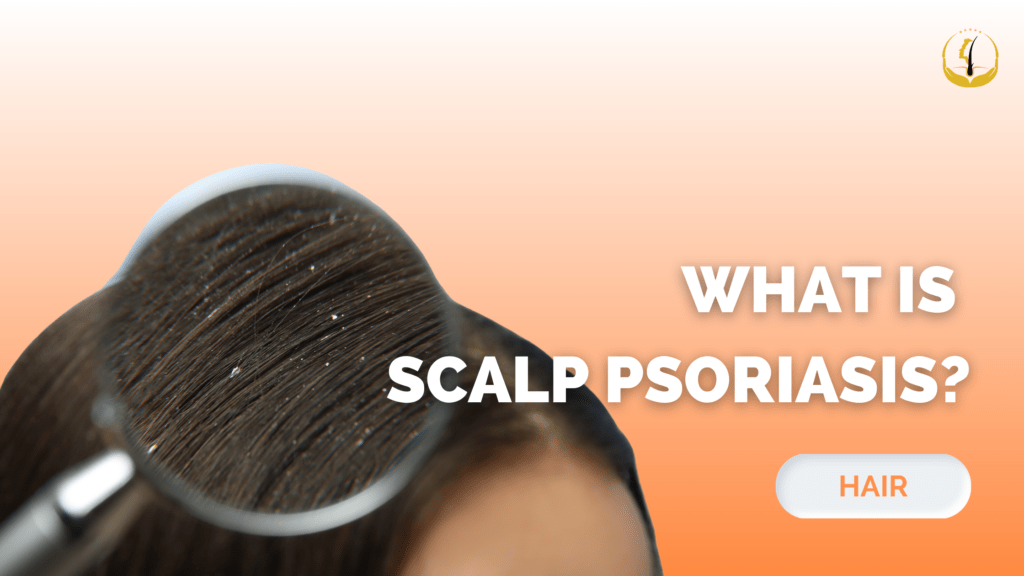
Scalp psoriasis, a chronic skin condition affecting millions globally, poses both physical discomfort and emotional stress. In this comprehensive discussion, we will delve into what it entails, exploring its causes, symptoms, and available treatment options. Understanding Scalp Psoriasis A specific type of psoriasis, involves the chronic autoimmune disorder characterized by the rapid buildup of skin cells. While a healthy individual experiences a natural skin cell growth cycle over a month, psoriasis accelerates this process. The result is the formation of thick, scaly, and itchy patches on the skin, specifically targeting the scalp. Causes The precise cause of psoriasis, including its manifestation on the scalp, remains elusive. However, it is widely acknowledged to be a complex interplay of genetic and environmental factors. Common triggers and risk factors associated with scalp psoriasis encompass: Genetics: Family history significantly increases the risk, with certain genes implicated in its development. Immune System Dysfunction: An overactive immune system attacks healthy skin cells, triggering the rapid turnover seen in psoriasis. Stress: Elevated stress levels correlate with the onset and exacerbation of psoriasis symptoms, including those on the scalp. Infections and Injuries: Infections like streptococcal throat infections and scalp injuries can provoke or worsen. Medications: Certain drugs, including lithium, beta-blockers, and antimalarial medications, are known to exacerbate psoriasis symptoms. Symptoms Scalp psoriasis manifests in diverse ways, with varying severity among individuals. Common symptoms include: Reddish patches: Skin patches covered with silvery scales or plaques. Itching and burning: Intense itching and discomfort often lead to scratching, exacerbating the condition. Flaking: Flakes resembling dandruff appear on the scalp, shoulders, and clothing. Hair loss: Severe cases may result in temporary hair loss, with regrowth typically occurring post-treatment. Dryness and cracking: Affected skin becomes dry, leading to cracking and, in severe cases, bleeding. Treatment While there is no outright cure, numerous treatment options can effectively manage symptoms and enhance the quality of life for those affected. These treatments encompass: Topical Treatments: Creams, ointments, and shampoos containing corticosteroids, coal tar, salicylic acid, or calcineurin inhibitors effectively reduce inflammation and scaling. Phototherapy: Controlled exposure to natural or artificial ultraviolet (UV) light slows down skin cell turnover. Oral Medications: In severe cases, immune system-suppressing medications like methotrexate, cyclosporine, or biologics may be prescribed. Lifestyle Changes: Stress management, a healthy diet, and avoidance of triggers like alcohol and smoking helps. Scalp psoriasis presents a challenging management scenario, but with the right approach and treatment, individuals can find relief from its symptoms and improve their quality of life. If suspecting scalp psoriasis, consulting a dermatologist for an accurate diagnosis and a tailored treatment plan is crucial. While a cure may be elusive, it is manageable, allowing individuals to lead fulfilling lives with proper care and attention.
Can Burshing Promote Hair Growth?
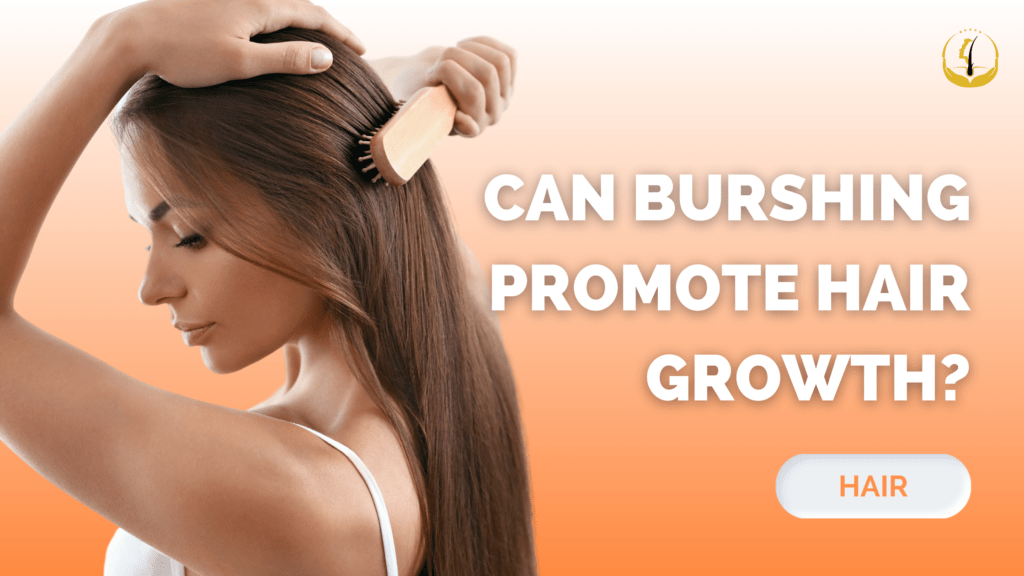
Many people dream of having thick, luxurious hair, and they are willing to try various methods to achieve it. One popular belief is that brushing your hair can promote hair growth. But is there any truth to this claim? Let’s explore the relationship between brushing and hair growth, considering the scientific evidence and expert opinions. The Brushing Myth The idea that brushing your hair can stimulate hair growth is a common myth. It’s often suggested that brushing improves blood circulation to the scalp, which in turn nourishes hair follicles and encourages hair growth. While this theory sounds plausible, it’s essential to examine the scientific basis behind it. The Truth About Brushing Brushing your hair does have some benefits, but it’s important to understand its limitations. Regular brushing helps distribute natural oils produced by the scalp, called sebum, along the hair shaft. This can make your hair appear shinier and healthier. Brushing also helps remove tangles and prevents hair breakage, which can make your hair look thicker. However, the idea that brushing alone can significantly promote hair growth is not supported by scientific evidence. Hair growth primarily depends on factors like genetics, hormones, diet, and overall health. While brushing can contribute to hair health, it’s not a magical solution for achieving Rapunzel-like hair. Brushing Techniques Matter If you choose to brush your hair regularly, it’s essential to use the right techniques and tools to minimize damage and maximize the benefits. Here are some tips: Use a gentle brush: Opt for a soft-bristle brush or a wide-toothed comb to avoid pulling and breaking your hair. Brush with care: Start brushing from the tips and work your way up to the roots. Be gentle and avoid aggressive brushing, especially when your hair is wet, as it’s more prone to damage when wet. Don’t overdo it: Excessive brushing can lead to hair breakage. Aim for a balance between keeping your hair tangle-free and avoiding over-brushing. Clean your brush: Regularly clean your brush to remove dirt, oils, and hair products, which can transfer to your hair and scalp. The Role of Scalp Massage While brushing alone may not promote hair growth, scalp massage is a technique that some people believe can have a positive impact. Scalp massage can improve blood circulation to the scalp, which may help deliver more nutrients to the hair follicles. However, it’s important to note that the effects of scalp massage on hair growth are still under research, and results may vary from person to person. In conclusion, while brushing your hair is an essential part of hair care, it’s not a guaranteed method for promoting hair growth. Hair growth is a complex process influenced by various factors, including genetics, hormones, and overall health. While brushing can contribute to hair health by distributing natural oils and preventing breakage, it’s not a magical solution for achieving rapid hair growth. If you’re concerned about hair loss or want to stimulate hair growth, it’s advisable to consult with GLOJAS experts. We can provide personalized advice and recommend treatments that are backed by scientific research. Remember that maintaining a healthy diet, managing stress, and avoiding harsh hair treatments are also crucial factors in maintaining and promoting hair growth. So, while brushing can be a part of your hair care routine, it’s not the only answer to achieving the luscious hair you desire. At Glojas, we welcome clients to reach out to us directly to schedule a free initial consultation. We offer guidance and valuable insights on how best to address your specific challenges. Let us assist you in navigating your journey with confidence and clarity.
Effective Remedies to Prevent Hair Thinning
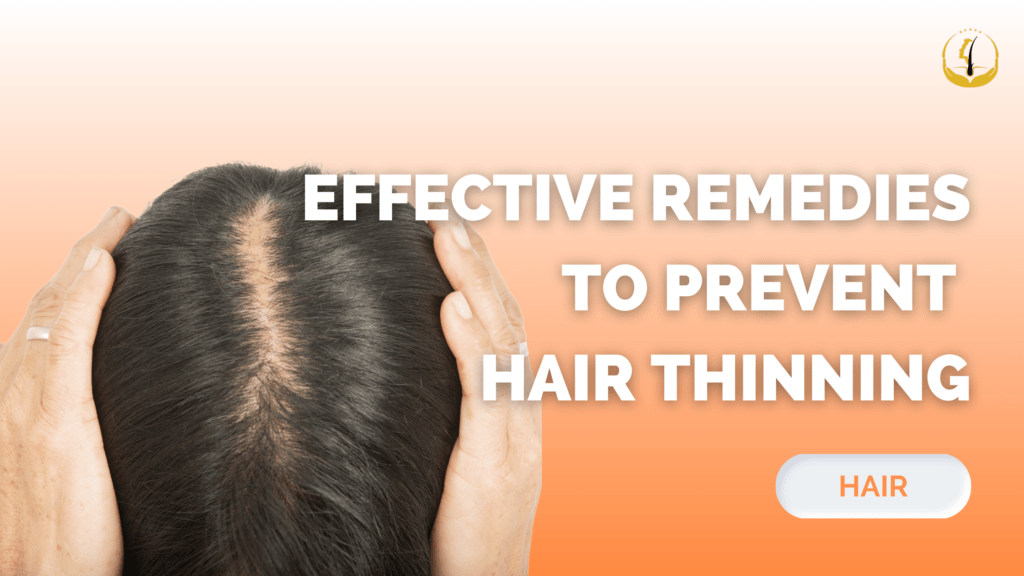
There are different factors that cause hair loss problem in men and women. These reasons might be heredity, a few medical conditions, improper hair care, and/or poor nutrition. While no one can control the genetic design, there are ways you can take to slow down your hair thinning problem and even help in hair regrowth, develop thicker strands, and enhance the general wellbeing of your hair. Are you facing a severe hair thinning problem and looking for ways to resolve the problem? If yes, then these tips can help you greatly. Try them today! Keep An Eye On What You’re Eating Your hair needs healthy food items to develop and to become stronger. Your diet must be filled with must-have fatty acids, protein, minerals, and vitamins. A few food items you need to ensure you’re routinely eating incorporate carrots, spinach, salmon, lean meats, sweet potatoes, lentils, nuts seeds, and yogurt. Poor diet, such as vitamin deficiency and insufficient protein consumption, can eventually lead to hair thinning. Crash dieting or the desire to get size zero can have the same impact as eating a junk food diet. It would help if you made sure that proper nutrition goes into your body by eating A wide range of fruits and veggies every day A lot of protein in Red meat and lean meat an excellent sources of protein, and those who don’t eat non-veg food can go for nuts, beans, cheese, and low-fat dairy products. Based on your height, weight, and nutritional goals, you must eat the right amount of calories every day. Leave The Hair Free Avoid pulling up your hair, so you can try loose hairstyles. Brushing your hair too much, constantly wearing it in a tight braid or bun, and wearing hair extensions too often can all result in hair thinning and breakage. Try Not To Overheat Every now and again styling with high heat can result in damage, harm and breakage. In case you’re worried about your hair thinning, utilize heat on rare occasions. Take Supplements Some vitamins can help to support hair development and fortify your strands. Everyday replenishing supplements help to empower hair development by supporting hair at the cell level. Stay Away From Gels, Sprays And Similar Items Heavy hair products can have severe adverse effects on the quality of your hair. These products might make your already existing hair thinning problem even worse. You should instead use light products that add volume. Yes, it’s true that you can get hair back on your head with a hair transplant, but it’s better to stop using these harmful products on your hair. Use A Gentle Shampoo Your hair will become thin and even break if too many chemicals are applied to it. So, always use a gentle quality shampoo that has a low amount of chemicals in it. Consult for FREE at GLOJAS Hair Specialist Clinic. We provide the best solution-oriented hair transplant with our specialist doctors and experts in their fields, treating all of our patients with honest, trustworthy, ethical, and equal service of the highest quality, meeting all the required national and international standards.
Is Regenera Activa Permanent?
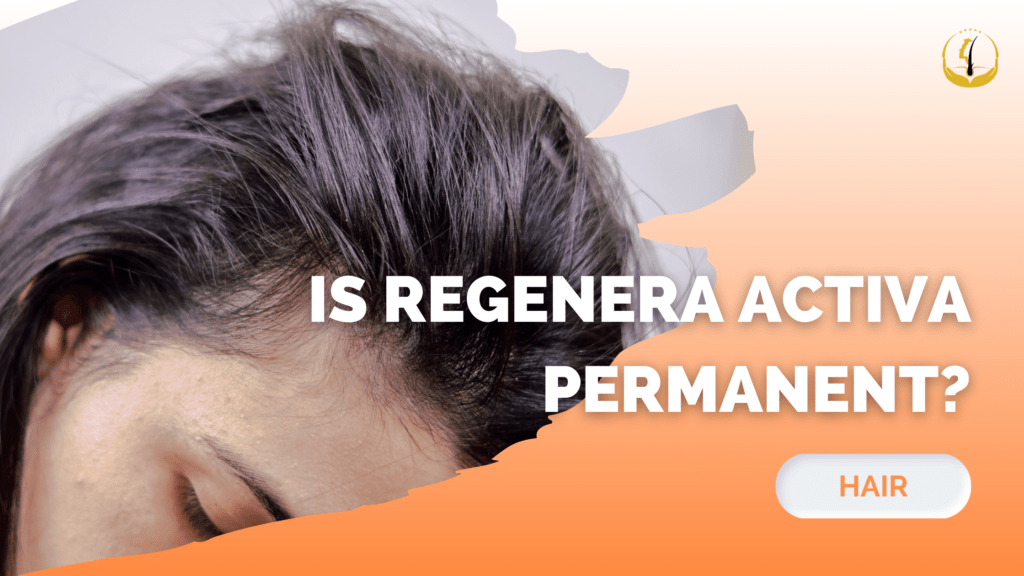
Hair loss can be a distressing experience for both men and women. Over the years, various treatments and products have emerged to combat this issue. One such innovation is Regenera Activa, a non-surgical hair restoration procedure that has gained popularity for its effectiveness. But the question on many minds is: Is Regenera Activa permanent? In this blog, we’ll delve into the science behind Regenera Activa and explore the longevity of its results. What is Regenera Activa? Regenera Activa is a cutting-edge non-surgical hair restoration technique that utilizes the power of autologous micrografts. Unlike traditional hair transplant procedures, Regenera Activa doesn’t involve surgery or the removal of hair follicles from one area of the body to another. Instead, it focuses on regenerating hair by using the patient’s own cells. The Procedure The Regenera Activa procedure begins with a small biopsy from the patient’s scalp, usually from the back of the head where hair loss is less likely to occur. This biopsy contains hair follicles and surrounding tissues. These tissues are then processed to obtain micrografts, which are rich in regenerative cells. These micrografts are injected into areas experiencing hair thinning or loss, stimulating the growth of new hair follicles. The Longevity of Results Now, let’s address the burning question: Is Regenera Activa permanent? While it’s true that Regenera Activa provides noticeable results, it’s important to understand that the permanence of these results can vary from person to person. Here are some key factors to consider: 1. Individual Variation: Hair loss is influenced by genetics, hormonal changes, and lifestyle factors. As a result, the response to Regenera Activa can differ among individuals. Some may experience longer-lasting results, while others may require periodic touch-up sessions. 2. Maintenance: Like any hair restoration treatment, maintenance plays a crucial role in preserving the results. Patients are often advised to follow a post-procedure care routine, including specific hair care products and lifestyle adjustments, to extend the longevity of their results. 3. Progressive Hair Loss: Regenera Activa can effectively address current hair loss concerns, but it may not prevent future hair loss. Hair loss can be an ongoing process, and additional treatments or adjustments may be needed over time. 4. Consultation and Monitoring: Regular consultations with a qualified healthcare professional are essential to assess the progress and determine if any follow-up treatments are necessary. Adjustments to the treatment plan can be made based on individual needs. In conclusion, the permanence of Regenera Activa results is subject to various factors, including individual genetics, maintenance, and the progression of hair loss. While some individuals may enjoy long-lasting results, others may require periodic touch-up sessions to maintain their desired level of hair density. Regenera Activa is a promising non-surgical hair restoration option for those seeking to address hair loss without the need for invasive surgery. However, it’s crucial to approach the treatment with realistic expectations and to consult with GLOJAS professionals who can provide personalized guidance based on your unique circumstances. Ultimately, the decision to undergo Regenera Activa or any other hair restoration treatment should be made after a thorough consultation and consideration of all available options. Remember that individual experiences may vary, and the permanence of the results depends on several factors. At Glojas, we welcome clients to reach out to us directly to schedule a free initial consultation. We offer guidance and valuable insights on how best to address your specific challenges. Let us assist you in navigating your journey with confidence and clarity.
How Often Should Wash or Shampoo Hair?
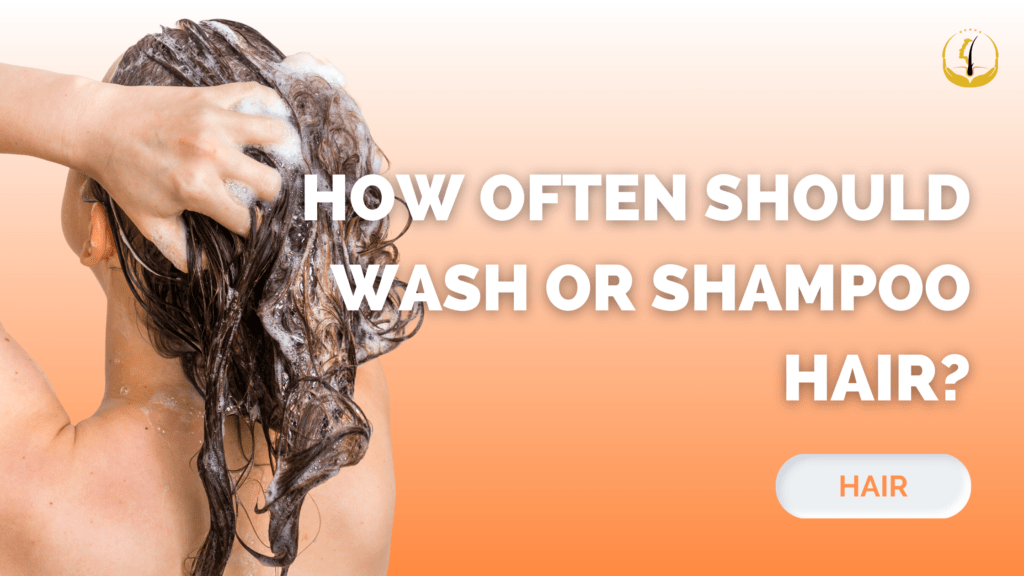
Achieving beautiful and healthy hair requires a delicate balance in your hair care routine. One of the common dilemmas faced by many is determining the optimal frequency for washing or shampooing their hair. Let’s delve into the factors influencing hair washing frequency and explore tips to help you maintain your locks. Understanding Your Hair Type Oily Hair: Recommended Frequency: Every other day or every two days. Rationale: Oily hair tends to appear greasy, and more frequent washing is necessary to keep it fresh. Normal Hair: Recommended Frequency: Every two to three days. Balance: Overwashing can strip natural oils, making this balance crucial for maintaining healthy hair. Dry Hair: Recommended Frequency: Every three to four days or once a week. Strategy: Less frequent washing helps retain natural oils and prevents excessive dryness. Curly or Coarse Hair: Recommended Frequency: Once a week or even less often. Reasoning: Curly and coarse hair tends to be drier, and overwashing can lead to frizz and breakage. Chemically Treated Hair: Recommended Frequency: Every two to three days. Importance: Gentle washing helps maintain color and prevents damage for chemically treated hair. Factors to Consider Apart from hair type, various factors can influence your hair washing routine: Lifestyle: Consideration: Active lifestyles or heavy sweating may require more frequent washing to remove sweat and prevent odor. Climate: Impact: Humid environments may lead to oilier hair faster, while dry climates may result in longer-lasting dryness. Styling Products: Buildup: Products like gels, hairsprays, and serums can build up, necessitating regular washing to remove residue. Scalp Health: Balancing Act: Maintaining a healthy scalp is crucial; overwashing can lead to dryness, while infrequent washing may cause oil buildup and scalp issues. Tips for Healthy Hair Washing Now that you understand how often to wash your hair, here are additional tips for maintaining healthy hair: Use the Right Shampoo: Guidance: Choose a shampoo that aligns with your hair type and specific needs, such as dandruff or color-treated hair. Avoid Hot Water: Preventive Measure: Hot water can strip natural oils; opt for lukewarm or cool water for hair washing. Condition Appropriately: Application: Apply conditioner mainly to the ends to avoid making the roots oily. Limit Heat Styling: Caution: Excessive use of heat styling tools can damage hair; use them sparingly and use heat protectant products. Protect Your Hair: Precaution: When swimming, wear a swim cap to shield your hair from chlorine and saltwater’s drying effects. Finding the right hair washing frequency is a personal journey that hinges on hair type, lifestyle, and individual needs. Striking a balance between keeping your hair clean and healthy without overwashing or underwashing is crucial. Pay attention to your hair’s signals and adjust your routine as needed for beautiful, vibrant locks. Consulting with a hairstylist or dermatologist can offer personalized guidance for your unique hair care routine.
Breaking the Silence: The Surprising Causes of Hair Loss
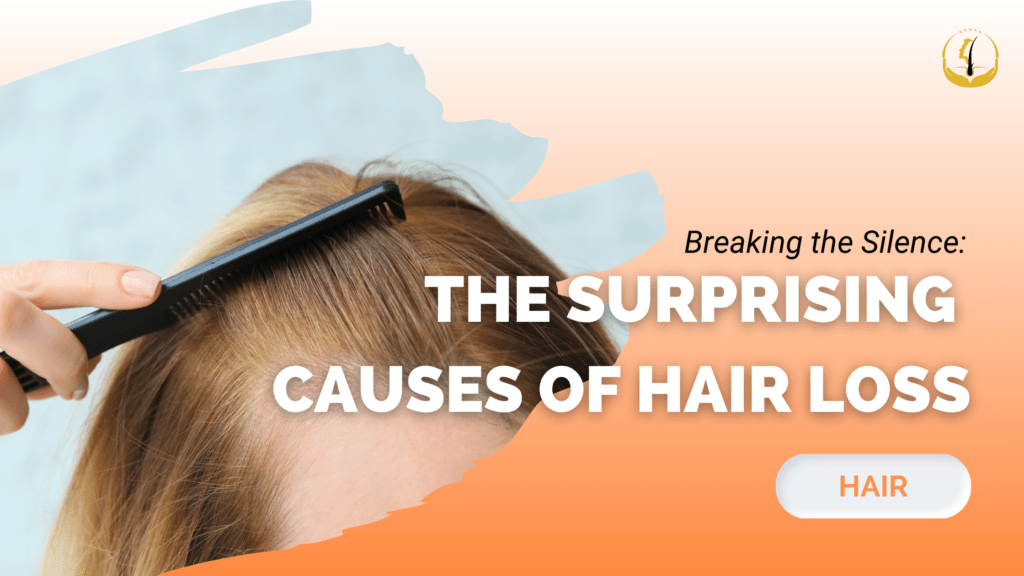
Hair loss is a major problem among men and women. Here are shocking causes of hair loss. Fortunately, balding can be treated with hair transplant surgery at GLOJAS Hair Specialist Clinic. Numerous hair loss conditions originate from hereditary problems, especially in instances of male pattern baldness, or androgenic alopecia. However, lifestyle and environment can result in diminishing and shedding on the scalp and even on the body. Large portions of these male pattern baldness cases are totally preventable, however finding out the cause which may be influencing male pattern baldness is vital to overcome and turn around the problem. Let’s take a look at these unexpected and shocking causes of hair loss. Stress Depression Mental issues don’t harm your interior health only. Stress depression can prompt physical issues, such as weight gain, weight reduction and baldness. Excess amount of stress hormones in the body intensifies adrenal fatigue, which happens due to the overproduction of cortisol. High amounts of cortisol are discharged by the adrenal glands and low production of other vital hormones like androgens and aldosterone, bringing about balding or thinning up top hair. Bad Eating Habits Vitamins and minerals are keys to guarantee that the human body works effectively, incorporating growth of hair. Lack of sufficient nutrients and supplements, circulation and oxygen levels in the scalp are reduced. A low-calorie or unhealthy eating habit may trigger short-term or long term balding, so monitoring what you decide to eat is critical.Make sure you’re receiving enough protein, the essential nutrient for healthy hair, through fish, white and red meat. Disease/Illness Ailment puts strain on the body and hinders its functions, and male pattern baldness or damage can be an early indication of other health issues. Thyroid dysfunction, specifically, is one problem that makes follicles close down and brings shedding or thinning on the scalp. Lupus, an immune system disorder, gives weak or broken hairs over the forehead. Lymphoma, a sort of cancer, can bring male pattern baldness. Hair loss is common in HIV patients, sarcoidosis, myotonic dystrophy and other chronic ailments. In some cases, baldness can be the first piece of information to another more serious illness, so watching out for your scalp health improves your chances of early ailment identification. If you want a reasonable cost for a hair transplant, GLOJAS Hair Clinic can fulfill your objectives. Consult with us for FREE! GLOJAS clinic has developed a team of experts who have full mastery of hair transplants and other cosmetic procedures.
Medication Following a Hair Transplant
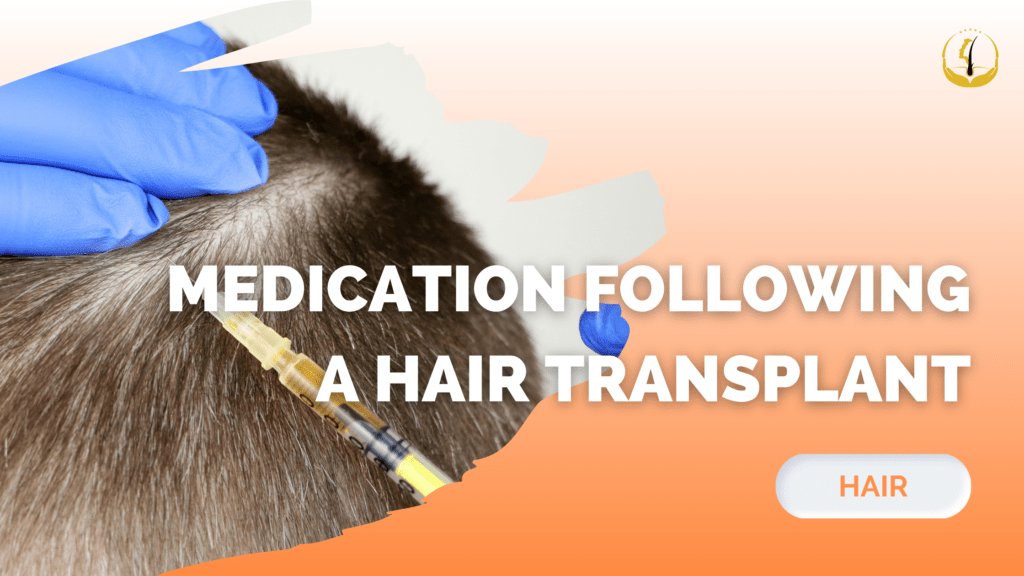
Hair transplants have become increasingly popular as a solution for hair loss, offering a chance to regain confidence and a full head of hair. However, the success of a hair transplant doesn’t solely depend on the procedure itself. Proper post-operative care, including medication, plays a crucial role in ensuring a successful and healthy recovery. In this blog, we will delve into the essential medications recommended following a hair transplant, focusing on the key aspects and benefits. SMART Medication Protocol Medication Protocol is a versatile approach to stimulate follicle growth, offering a flexible solution for individuals considering hair restoration, and it is exclusively available at GLOJAS. Whether used in conjunction with a hair transplant procedure or as a standalone treatment, this protocol harnesses the power of specialized medications to encourage the growth of healthy hair follicles. Antibiotics After a hair transplant, your scalp is vulnerable to bacterial infections. To prevent this, your surgeon may prescribe antibiotics. These medications are crucial in warding off potential infections that could lead to complications and negatively impact the results of the transplant. It’s vital to complete the full course of antibiotics as prescribed, even if you start feeling better sooner. Pain Medication It’s common to experience some discomfort or pain after a hair transplant procedure. Your surgeon will typically recommend pain medication to manage this. Non-prescription pain relievers like ibuprofen or acetaminophen may suffice for mild discomfort, while stronger prescription pain medication may be necessary for more severe pain. Always follow the dosing instructions provided by your healthcare provider. Anti-Inflammatory Drugs Swelling and redness are common side effects after a hair transplant. To reduce these symptoms and promote a quicker recovery, your doctor may prescribe anti-inflammatory drugs. These medications can help manage swelling and discomfort, ensuring that you are more comfortable during the healing process. Finasteride Finasteride is an oral medication that can help slow down or prevent further hair loss. It works by inhibiting the action of the hormone dihydrotestosterone (DHT), which is responsible for hair loss in genetically predisposed individuals. While it may not directly affect the transplanted hair, it can help protect your existing hair and maintain long-term results. Minoxidil Minoxidil is a topical solution that can stimulate hair growth and improve the overall appearance of your hair. It’s typically used to enhance the results of a hair transplant. Your surgeon may recommend starting minoxidil a few weeks after the procedure to encourage the growth of newly transplanted follicles and improve the density of the surrounding hair. Steroid Medications Steroid medications can help reduce inflammation and swelling post-surgery. Your surgeon may administer a short course of steroids during the immediate post-operative period to minimize these side effects and facilitate a smoother recovery. Biotin Supplements Biotin, a B-vitamin, is essential for healthy hair growth. While it won’t directly affect the success of your hair transplant, taking biotin supplements can support overall hair health. Consult with your surgeon or a healthcare professional before starting any new supplements to ensure they won’t interfere with your recovery or medications. In conclusion, proper medication following a hair transplant is crucial for a successful and comfortable recovery. These medications, all play essential roles in ensuring your newly transplanted hair thrives and your overall experience is positive. Remember to follow your surgeon’s instructions diligently and attend all follow-up appointments. It’s also essential to maintain a healthy lifestyle, including a balanced diet and proper hair care, to maximize the results of your hair transplant. By taking these steps and following your medication regimen, you can look forward to enjoying a fuller, more confident head of hair after your hair transplant procedure. Click the link to learn more about Medications: “Finasteride for Hair Loss” At Glojas, we welcome clients to reach out to us directly to schedule a free initial consultation. We offer guidance and valuable insights on how best to address your specific challenges. Let us assist you in navigating your journey with confidence and clarity.
Is a Hair Transplant with Another Person’s Hair Possible?
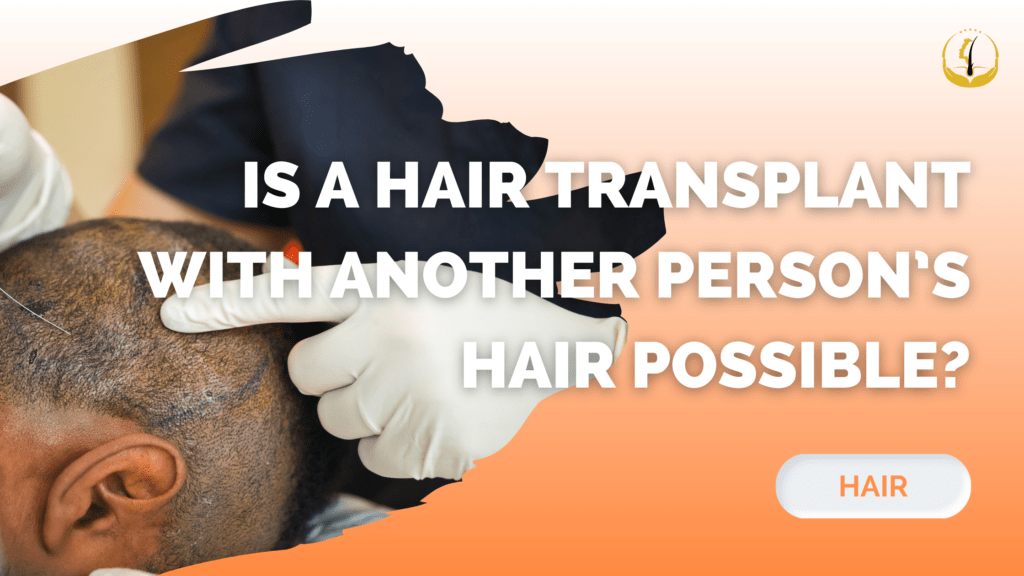
Hair loss is a common concern for many individuals, affecting both men and women as they age. While there are various treatments and remedies available, one question that often arises is whether it’s possible to undergo a hair transplant malaysia using another person’s hair. In today’s blog post, we will explore the feasibility and ethical considerations of such a procedure. What Are Hair Transplants? Before delving into the topic of using another person’s hair for a transplant, it’s essential to understand the basics of a hair transplant procedure. Hair transplantation is a surgical technique that involves removing hair follicles from one part of the body (usually the back or sides of the scalp, where hair is genetically resistant to balding) and transplanting them to an area with thinning or no hair. This process is typically used to restore hair in areas affected by male and female pattern baldness. The Compatibility Issue The first hurdle in using another person’s hair for a transplant is the issue of compatibility. Human bodies have a unique immune system that distinguishes between self and non-self tissues. When foreign tissues, such as hair follicles from another person, are introduced into the body, the immune system may identify them as foreign invaders and mount an immune response. This can lead to the rejection of the transplanted hair follicles, causing the procedure to fail. Immunosuppression To overcome the compatibility issue, immunosuppressive drugs could potentially be used. These drugs are designed to suppress the immune system’s response, reducing the chances of rejection. However, using immunosuppressive drugs carries significant risks, including an increased susceptibility to infections and other health complications. Therefore, the use of these drugs for a hair transplant with another person’s hair is not a practical or ethical solution. Ethical Considerations Aside from the technical challenges, there are ethical considerations to take into account when contemplating a hair transplant using another person’s hair. Hair transplantation is typically performed with the patient’s own hair follicles or, in some cases, with hair grafts from a compatible donor (such as a family member). This approach ensures that the transplanted hair is genetically similar to the recipient’s, reducing the risk of rejection and achieving a more natural appearance. Using hair from an unrelated donor raises ethical concerns related to consent, ownership, and the commodification of human tissue. It’s essential to respect an individual’s autonomy and bodily integrity, and using their hair without their informed and voluntary consent would be ethically questionable. Alternative Solutions Rather than pursuing a hair transplant with another person’s hair, there are alternative solutions available for individuals struggling with hair loss. These options include: Autologous Hair Transplantation: This involves transplanting a person’s own hair from one area of the body to another. Since it’s the individual’s own hair, there’s no risk of rejection. Hair Loss Medications: FDA-approved medications such as minoxidil and finasteride can slow down or even reverse hair loss in some cases. Platelet-Rich Plasma (PRP) Therapy: PRP therapy involves injecting a patient’s own platelet-rich plasma into the scalp to stimulate hair follicle growth. Wigs and Hairpieces: Non-surgical options like wigs and hairpieces can provide a quick and effective way to address hair loss. In summary, while the idea of a hair transplant using another person’s hair may seem appealing, it is fraught with technical challenges, immunosuppressive risks, and ethical concerns. The current state of medical science does not support the feasibility of such a procedure. Instead, individuals seeking to address hair loss should explore alternative treatments and consult with GLOJAS hair experts to determine the most suitable approach for their specific needs. Ultimately, respecting ethical principles and prioritizing patient safety should guide decisions in the field of hair transplantation. Click the link to learn more about Hair Transplants: Hair Transplantation Frequently Asked Questions At Glojas, we welcome clients to reach out to us directly to schedule a free initial consultation. We offer guidance and valuable insights on how best to address your specific challenges. Let us assist you in navigating your journey with confidence and clarity.